Whims of Fate Reforged, Part 2
Welcome to the second Fate Reforged Preview Week. Last week, I began telling you the tale of the design of the pivotal middle set of the Khans of Tarkir block. So much happened during exploratory design that last week's article ended just as the main design of Khans of Tarkir had begun. This week, I catch us up to Fate Reforged's design and explain how all the pieces came together.
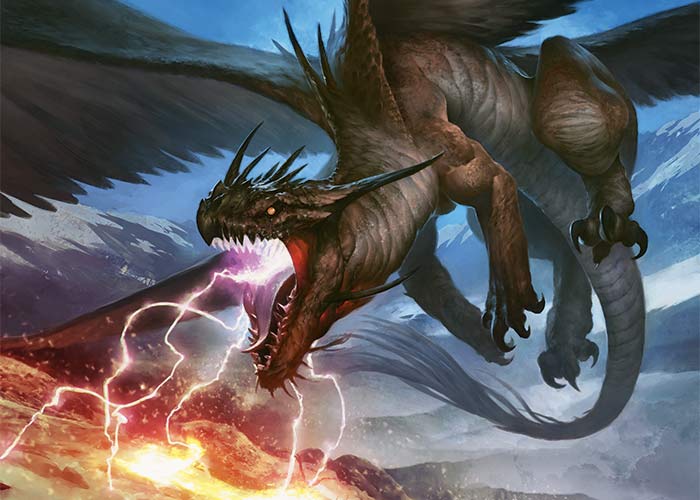
Art by Alejandro Mirabel
Before we begin, I need to discuss the elephant in the room, or in this case, article. This article is very hard to write because I both want to keep as much of Dragons of Tarkir a secret as I can and because I want it to be new and exciting when it comes out later this year. At the same time, I want to properly explain Fate Reforged's design, which was all about adjusting between the themes of the two large sets. In the end, I've decided to hint slightly at Dragons of Tarkir without telling you the exact details. I know this will be a bit frustrating at times, as it makes the story of Fate Reforged's design harder to follow, but I believe it's the best compromise for the problem at hand.
Just the Factions
I wrote a whole bunch of articles about Khans of Tarkir's design, so I'm going to quickly recap and catch us up with the start of the design of Fate Reforged. Khans of Tarkir design started with four factions, each tied to a different clan as well as a different attribute of the dragon. Four quickly became five and, before we knew it, Khans of Tarkir found itself with a wedge theme. As I've said in numerous other articles, Khans of Tarkir was a wedge set but not a wedge block. It's time to start talking about what exactly I mean by that.
When the block structure was laid out, we followed our time-travel structure. Set 1 was the world in turmoil, a place that would feel fundamentally flawed to our protagonist. Set 2 was the past, where our hero would travel to try and set the world right. Set 3 would be the alternative version of the present, where we would see the outcome of the actions of our main character during the second set.
Structurally, this meant one thing. Set 1 and Set 3 had to play very differently from one another. The entire structure of the second set, which pivoted between the two large sets, only worked if there was a substantial difference between those two. If Set 1 and Set 3 were too close, the shift of Set 2 from drafting with Set 1 to drafting with Set 3 would be meaningless.
The block structure only worked if there was a stark difference between the two. In addition, in order for the story to pay off, the actions of our hero had to have a big impact on his or her world. If Set 3 wasn't enough of a departure it would undercut the premise of the story. But, and this is important, both Set 1 and Set 3 had to feel as if they came out of the world shown in Set 2. We had to make the players feel as if we have traveled back to a time where either outcome is possible.
But wait, we had one more issue we also had to deal with: In order to keep the complexity at the right level, we had to keep an eye on how many mechanics the block had. Normally, the upper limit of what we feel is acceptable in a three-set block is twelve keyword mechanics and/or ability words. Khans of Tarkir needed one mechanic per faction and used morph. That's six mechanics. The first set used up half of our total allocation. (Normally, by the way, we tend to have five, so this isn't too far from normal. Later sets tend to reuse many of the mechanics.)
The key to solving this problem rested in an interesting solution. Dragons of Tarkir wanted to structurally mirror Khans of Tarkir. The two sets represent different versions of the same world, but they needed to each have their own identities. This meant that Dragons of Tarkir also wanted five factions, each with its own mechanic as well as a variant of morph. But that would be five more mechanics, possibly six depending on how you tweaked morph. So Khans of Tarkir and Dragons of Tarkir had eleven to twelve mechanics between them. And Fate Reforged had at least one new mechanic, with manifest. That meant we were out of room for mechanics and Fate Reforged's design hadn't even started yet.
Past Transgressions
Let's recap. Here are the things Fate Reforged had to do:
1. Play nicely with Khans of Tarkir.
2. Play nicely with Dragons of Tarkir.
3. Play differently with each.
4. Feel like the past that has the potential to become either Khans of Tarkir or Dragons of Tarkir.
5. Other than manifest, not use any new mechanics.
If restrictions breed creativity, then Fate Reforged was going to breed a lot of creativity.
Khans of Tarkir was a wedge set with five factions. Dragons of Tarkir is going to be a [CENSORED] set with five factions. The five factions of both sets have their origins in Fate Reforged. Each of these factions has a mechanic associated with it. How could we show that Fate Reforged is the precursor to both large sets while also not generating new mechanics? What if the proto-factions in Fate Reforged used mechanics from the large sets, some of each to show that both futures were seeded in the past?
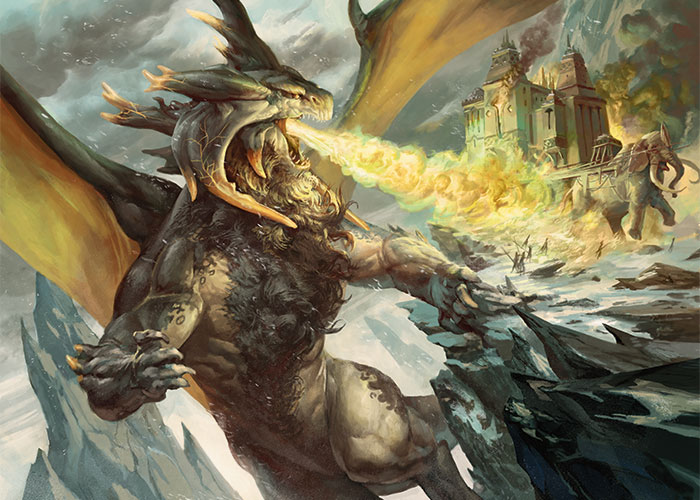
Art by Peter Mohrbacher
Here's the idea—we would take three mechanics from Khans of Tarkir and two mechanics from Dragons of Tarkir (two because, along with manifest, it would give Fate Reforged three new mechanics and Dragons of Tarkir three new mechanics plus the twist on morph). The big question for the Fate Reforged design team was which mechanics would we take from each.
Be aware that before the Fate Reforged design team met for the first time, the Dragons of Tarkir design team was already up and running. Large sets get a full year of design while small sets get four months. This meant that Fate Reforged had a peek into both large sets (which, by the way, was fundamental to its design). It's also important to understand that the five factions from Khans of Tarkir were connected (in an as-yet undisclosed way) with the five factions from Dragons of Tarkir. Because of this, the mechanics from the connecting clans were designed to play nicely with one another. As two of the Dragons of Tarkir faction mechanics would be premiered in Fate Reforged, that meant Khans of Tarkir/Fate Reforged would show off two of these interconnected mechanics while Dragons of Tarkir/Fate Reforged would show off the other three.
The big question was which mechanics would Fate Reforged use? Khans of Tarkir had five faction mechanics: outlast, prowess, delve, raid, and ferocious. The key to figuring out which three to use came down to a few questions:
#1) Which mechanic(s) had enough design space to fill two sets?
The answer was prowess, delve, raid, and ferocious. Outlast is a fun mechanic but it's the most limited of the five Khans of Tarkir mechanics. It had enough design space for a large set but getting another small set out of it would be tricky.
#2) Which mechanic(s) did we feel the audience would be most upset about if it didn't appear in a second set?
The answer to this question was delve. We first premiered it on three futureshifted cards in Future Sight and players have been asking for it ever since. Using delve in just one set felt wrong.
#3) Which mechanics from Dragons of Tarkir did we really want to use?
The reason this is important is that the Dragons of Tarkir mechanics line up (once again in an as-yet undisclosed way—I promise one day I'll explain it) with the Khans of Tarkir mechanics. When we found a mechanic in Dragons of Tarkir that we thought would be a good fit, it meant we had to remove the mechanic that lined up with it. That ended up being raid. Raid is a great mechanic with plenty more potential, but things just worked out better if we let it go in Fate Reforged. Raid works well and I am confident we will see it again one day.
That means we were left with prowess, delve, and ferocious.
On the Dragons of Tarkir side, we were left with bolster and dash. (Does anyone else think that sounds kind of like a 70s cop show?)
A Mad Dash
I'm going to start with the origin of the dash mechanic, as it came chronologically first. One day, Mark Gottlieb (he was the lead designer for Dragons of Tarkir) asked all of the members of the design team (Dan Emmons, Graeme Hopkins, Colin Kawakami, Sam Stoddard, and myself) to turn in ideas for new mechanics. We each emailed our card designs to Gottlieb and we discussed them at the next team meeting. In those emails, Sam Stoddard and I sent in the exact same idea—something I called blitz but is now known as dash.
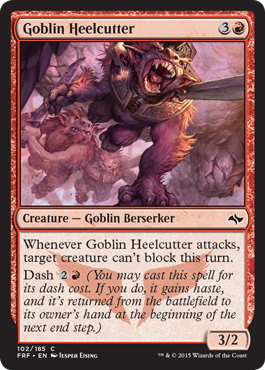
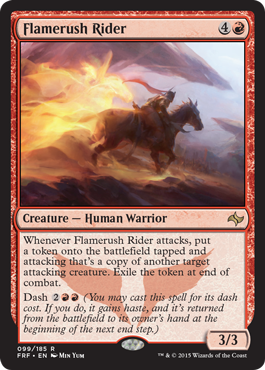
Dash was created because we were trying to make a mechanic that played nicely with raid. Well, raid wanted to encourage attacking, so why not create a mechanic that heavily encouraged attacking? We did this by creating a creature mechanic that allows the creature's controller to pay a cost (usually less) to give the creature haste the turn it is cast. The tradeoff is that at the end of the turn, if you paid the dash cost, the creature returns to your hand. While we made plenty of "vanilla" creatures with dash, we also found numerous ways to make the bouncing back component something that could be positive.
Dash played wonderfully and worked sweetly with raid because it allowed you to get in attacks that you might not otherwise be able to. It also worked nicely with raid because it allowed you to pick up cheaper raid creatures that might not have gotten the bonus when played early. It became obvious pretty quickly, when we were looking for Dragons of Tarkir mechanics to move back, that dash was a perfect choice.
Bolstering for Soup
The dash mechanic came early in Dragons of Tarkir design. Bolster came late. It was the last of the five faction mechanics we settled on. This was extra tricky for Fate Reforged design because it meant we were constantly swapping around what five mechanics we had as the Dragons of Tarkir design file kept changing.
Bolster came about because we were trying to make a mechanic that both thematically made sense with the appropriate faction in Dragons of Tarkir and played well with outlast. Raid was a much easier mechanic to pair with as there are many different ways to interact with attacking. Outlast, on the other hand, was about growing, so it was a little trickier. The obvious choice was a mechanic that cared about how big creatures were, as outlast continually puts +1/+1 counters on creatures. The problem was that was exactly what ferocious, the Temur mechanic, had done. We did that to make the two mechanics work well with one another, but it had painted us into a bit of a corner.
The next obvious place to go was a mechanic that cared about +1/+1 counters. The problem there was Khans of Tarkir development, to make the outlast deck have more linear elements to it, added in a bunch of cards that granted abilities to creatures with +1/+1 counters. Finally, one day we decided to try mechanics that put +1/+1 counters on creatures. This would interact with the "+1/+1 counter matters" stuff development had added to Khans of Tarkir. This attempt proved to be the successful one.
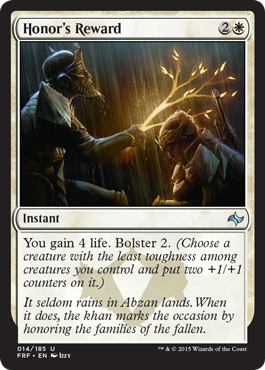
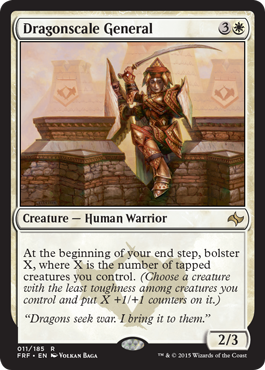
Our earliest attempt was a mechanic that could directly choose where to put the +1/+1 counters, but it ended up both being a bit too strong and didn't play as well as we'd hoped. The key, we found, was having the mechanic put a limitation on which card got the +1/+1 counters. Instead of always piling it on your biggest creature, what if it made your smallest creature bigger? This prevented the "rich get richer" issue we were having and also ended up making the gameplay a lot more interesting.
A quick side note to point out an important game-design point. Games are, at their core, about mental challenges. The goal of a game is to give the players obstacles they are forced to overcome. At first blush, players might assume what they want in a mechanic is the ability to do whatever they wish in the most powerful form available, but what actually makes the game better is if what the players get is something they have to accommodate for. Games are more fun if you have to make do rather than just getting what you want.
We went through many iterations to get to bolster but, once we tried it, it was clear we had found our mechanic. It also became clear that bolster needed to be in Fate Reforged, as outlast didn't have the design depth to fill a second set to our satisfaction.
"Pivot! Pivot! Pivot!"
Okay, Fate Reforged had its five clan mechanics and its proto-morph variant. Next came the bigger challenge: figuring out how to make a set that played well with Khans of Tarkir but then played well with Dragons of Tarkir, but in a different way. Part of this was accomplished by the fact that each large set had its own theme and structure. Fate Reforged was going to have to figure out how to fit into both. Khans of Tarkir is a wedge set. Dragons of Tarkir is a…well, not a wedge set. How could we make a set that played nicely with a wedge set play nicely with something that isn't?
The hardest example of this problem came when making our cycle of clan leaders. Fate Reforged takes place more than 1,000 years earlier. The clans existed but were far less entrenched and their leaders obviously were different people, as the khans from Fate Reforged were centuries from being born. We wanted the clan leaders to serve as commanders for decks built both around the Khans of Tarkir factions and the Dragons of Tarkir factions, but how could a card be both a wedge card and not a wedge card?
My preview card today answers this question. (Okay, it is one way to answer this question—Fate Reforged solved its pivot issue in multiple ways.) So before I explain the solution to this problem, let me introduce you to Tasigur, the Golden Fang.
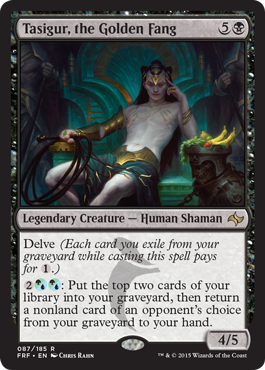
The solution to this problem rested in the hybrid mechanic. By being a monocolor legendary creature with a hybrid activation, these khans are three colors within Commander rules (color identity counts the color of any mana activations on the card).
The Choice is Yours
Another way to help define the two potential futures was to make choice a key theme in the set's design. Numerous cards in the set give you two options when casting a card. This allows you, the player, to choose which path you go down. Some choices are even woven into the very choice that Sarkhan has to make.
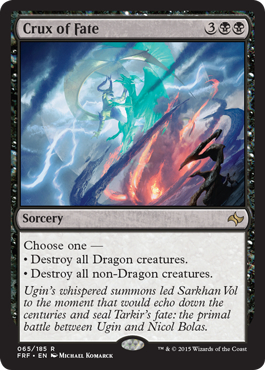
There are a number of cards that have you choose between "khans" and "dragons" and play up that this set is the crossroads to two different timelines.
Dragon On
Speaking of dragons, in Khans of Tarkir, the dragons had all been killed off, but 1,000 years back in time, the world still abounds with dragons. Fate Reforged had to address this, which meant the set needed some Dragons. First up was a cycle of legendary Dragons. These were the very dragons whose attributes the clans chose to model themselves after.
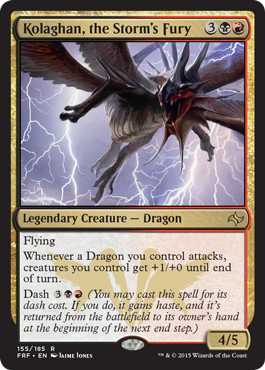
The legendary Dragons were designed so they could have decks built around them but also fit into the clan decks that played up their attributes. Get to know these five dragons. Let's just say they might be very important.
Next came an uncommon cycle. These were made monocolor and designed more with Limited in mind. Each is a 4/4 Dragon for six mana (four colorless and two colored) each with an in-color ability. These were designed to be relevant in Limited without being too overwhelming.
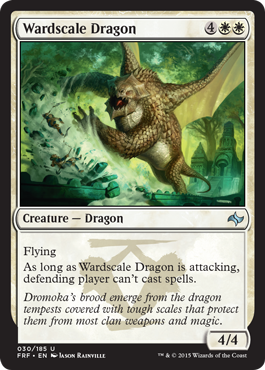
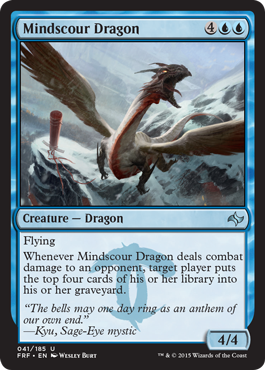
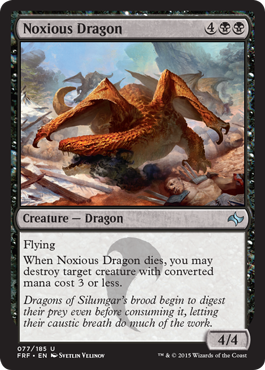
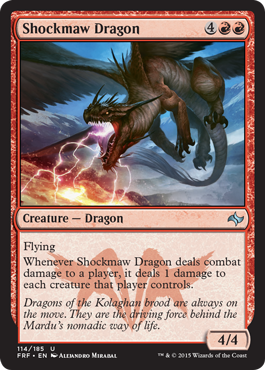
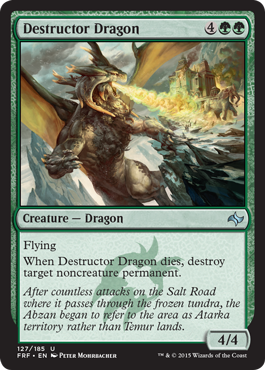
Finally, because Dragons are iconic in red, it got one common Dragon—something that had all the flavor of a Dragon but could be played in many decks without causing huge Limited issues. What does that Dragon look like? I'll be previewing it tomorrow on Twitter, so stay tuned!
This does, of course, bring up the "What are Dragons doing in colors other than red?" question. We have done market research on creature types and, by far, the most popular creature type is Dragon. As such, we have chosen to infrequently allow cycles of Dragons ( Legends , Mirage , Invasion , Planar Chaos , and Champions of Kamigawa ). It's not something we do often, but as a special treat every once in a long while. This block felt like one of those special places, so for a short time every color gets to have some Dragons. Their inclusion could not be more key to the block's design.
Up To Fate Reforged
As you can see, Fate Reforged does everything it can to be the precursor to both Khans of Tarkir and Dragons of Tarkir. Much of the set ties mechanically into what we did in Khans of Tarkir. The rest, though, are clues to another future. I've been a bit mysterious about what exactly Dragons of Tarkir is up to, but a lot of hints are woven into the design choices made for Fate Reforged. Sarkhan has come back to the past to make a fateful choice, the outcome of which you all will get to play later this year. For now, though, you get a chance to enjoy Tarkir as it used to be, back when the dragons were alive and the clans were in their infancy. Enjoy!
As always, I am eager for your feedback either through my email or any of my social media (Twitter, Tumblr, Google+, or Instagram).
Join me next week, when I'll go card by card to share some individual design stories.
Until then, may you enjoy your choices.

